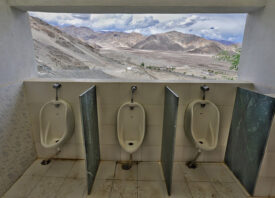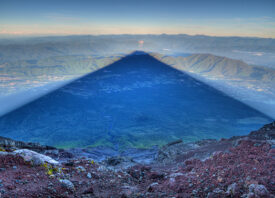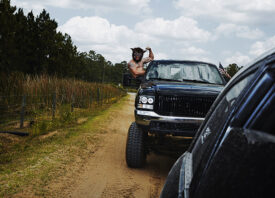Search this site
Landscapes Touched by Violence, Conflict, and Beauty, in Photos

Stone Mountain is Georgia’s most-visited tourist attraction and the site of the largest high-relief sculpture on the planet. That carving is also the United States’ largest Confederate monument, its history entwined with the rebirth of the Ku Klux Clan. In recent years, it’s been a rallying point for white supremacists groups. Everyone will have a different response to Kris Graves’s now-famous photograph of the monument, but looking at it now, I can’t help but think the carving looks like an open wound. For me, it calls to mind the word Stacey Abrams once used to describe that same monument: a “blight”–a disease or injury.
Kris Graves is one of twelve photographers featured in Pained Vistas, an extraordinary exhibition curated by Jon Feinstein and Roula Seikaly of Humble Arts Foundation. On view at Photographic Center Northwest (PCNW) through March 17th, the show spans landscapes across the globe, many touched in one way or another by conflict or trauma.

For instance, Selena Kearney photographs a vast and open space in Eastern Washington, recalling a complex history that reshaped the lives of Indigenous peoples and European settlers for generations. Donna J. Wan retraced the steps of people who have killed themselves, photographing bridges and beaches that are sites of beauty but also death and grief.


Wendel White traveled across New Jersey, Pennsylvania, Ohio, Indiana, and Illinois to photograph the remains of segregated schoolhouses in the northern United States. The surrounding landscapes have been obscured digitally as if overlaid by a veil–a reference to WEB Du Bois’s indelible description of racism and segregation. Meanwhile, Dionne Lee explores the history of survival in the American landscape. And Kelsey Sucena harnesses the tradition of the American road trip while also investigating whose voices have been historically overlooked and left out, including those of queer and nonbinary/trans people.


Griselda San Martin takes us to the border wall separating Tijuana, Mexico from San Diego, California–specifically to Friendship Park, where loved ones come to meet on either side of the fence. Yazan Khalili photographed the twinkling lights of Yaffa while stuck in Birzeit during an Israeli offensive in West Bank in 2002, and six years later, Irina Rozovsky traveled across Israel, capturing a dusty, sun-baked landscape.


Marc Wilson, listening to the stories of twenty-two people and families, has spent the last six years photographing landscapes significant to people who survived or were murdered during the Holocaust. In one photograph, part of his book A Wounded Landscape, he takes us into Radostowitz, a sub-camp of the Auschwitz concentration camp in the Pszczyna forests. “Prisoners worked felling trees, which were transported to Auschwitz II-Birkenau and used to burn bodies in the crematoria,” Wilson explains. He traveled there in 2016, fewer than seventy-five years since prisoners were held there.

As Seikaly explains, Pained Vistas was curated to honor loss and death–but not to aestheticize trauma. At the same time, many of the pictures share an ambiguity and open-endedness that allow for pain as well as beauty and resilience–sometimes simultaneously. “This picture is the blood of a bowhead whale washing up onto the sea ice in North Alaska,” Kiliii Yuyan shared, referring to one of his images in the exhibition. “By and large, throughout the world, most people when they see this picture, it’s one of dread or something like that.

“But I see this much in the way that many Iñupiaq see this, which is full of joy, happiness, and remembrance of a successful hunt […] That pride is informed by millennia of management of the Iñupiaq’s marine relatives. That stewardship resulted in the threefold increase of the whale population after the Iñupiaq regained their right to harvest and manage the bowhead population thirty years ago.” The landscapes in Pained Vistas have complex histories, with layers upon layers of meaning and memory.
In many cases, those histories aren’t relegated solely to the past. They’re also playing out in real-time. Last year, for example, officials in Georgia voted to make some changes to Stone Mountain Park, including “telling the whole story” behind the Confederate carving and its relationship to the Ku Klux Clan. Confederate flags that had long stood at the base of the mountain were also moved to another location.
As of this writing, however, the carving itself, featuring Confederate leaders Robert E. Lee and Thomas “Stonewall” Jackson, is still there. Perhaps it’s worth noting that Kris Graves made another picture at Stone Mountain. It’s not in the show, but in the past, he’s shared on his Instagram account and also released as an NFT. It’s a self-portrait. The artist’s arm is raised, his middle finger extended. The carving might still be there, but it’s not the most important part of the picture. Graves is.
See Pained Vistas at Photographic Center Northwest (PCNW) through March 17th. Tune into the Artist Talk here.



